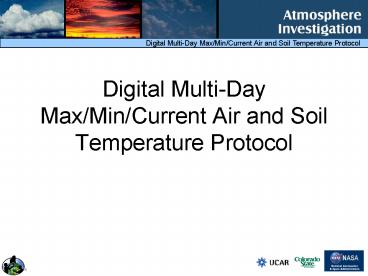Digital Multi-Day Max/Min/Current Air and Soil Temperature Protocol - PowerPoint PPT Presentation
1 / 16
Title:
Digital Multi-Day Max/Min/Current Air and Soil Temperature Protocol
Description:
One measures soil temperature at a depth of 10cm. Stores six days of max/min temperatures ... DM-D M/M Current Temperature Protocol Field Guide ... – PowerPoint PPT presentation
Number of Views:68
Avg rating:3.0/5.0
Title: Digital Multi-Day Max/Min/Current Air and Soil Temperature Protocol
1
Digital Multi-Day Max/Min/Current Air and Soil
Temperature Protocol
2
Goals for the Training Session
- Provide an inquiry context for the data
collection and science content - Provide accurate science content
- Review procedures for data collection
- Review data entry and analysis
- Discuss classroom implementation ideas
- Collect feedback from participants
3
Inquiry Context
- Which season has the highest temperature? Lowest
temperature? Why? - How does the soil temperature range compare with
the air temperature range? - What are the latitudes and elevations of other
GLOBE schools with atmosphere temperature data
similar to yours?
4
Local Inquiry Example
5
Why do GLOBE scientists research Max/Min/Current
Air and Soil Temperature?
- To provide a denser network of observations than
is available using only official weather stations
for investigating localized variations - To augment data needed for regional forecasts and
climate records in areas of the world where there
are few official weather stations - To compare with model data, or to use as input to
run a model
6
Science Content
7
Instruments Digital Multi-day Max / Min
Thermometer
- Two sensors
- One measures air temperature
- One measures soil temperature at a depth of 10cm
- Stores six days of max/min temperatures
- Must be reset to around the time of local solar
noon one time when it is first set up - The exact time it is reset is known as the Time
of Reset
8
The Measurements
- Digital Thermometer Calibration
- Current temperature for air and soil
- Daily maximum and minimum temperatures for air
and soil
9
Collecting Data Field/Lab Guides Data Sheets
- Field/Lab Guides
- Thermometer Calibration Lab Guide
- DM-D M/M Thermometer Sensor Calibration Field
Guide - DM-D M/M Thermometer Installation Field Guide
- DM-D M/M Thermometer Reset Field Guide
- DM-D M/M Temperature Protocol Field Guide
- DM-D M/M Current Temperature Protocol Field Guide
- DM-D M/M Current Soil Sensor Error Check
Lab/Field Guide - Changing the Battery in the DM-D M/M Thermometer
Field Guide - Data Sheets
- DM-D M/M Thermometer Calibration and Reset Data
Sheet - DM-D M/M Thermometer Data Sheet
10
Collecting Data Calibration
- Submerge calibration thermometer in an ice-water
bath for 10-15 minutes, stir occasionally - Calibration thermometer should read between -0.5
C and 0.5 C - Hang calibration thermometer in instrument
shelter - Read five sets of readings
- Record and report data
- to GLOBE Web site
11
Collecting Data Protocol
- For both air and soil temperatures
- Press ON button to read current temperature
- Press the Max/Min button twice to read
maximum/minimum temperature of first day (D.1) - Continue to press Max/Min Button once to read
temperatures of other days (D.2-D.6)
Min
SOIL
AIR
12
Enter Data on the GLOBE Web Site
Step 1 Confirm that the atmospheric
study site definition is completed Step 2
Select Digital Thermometer
Calibration and Reset from the
atmosphere data entry menu Step 3 Enter date/UT
time/select site/ Step 4 Enter calibration
data Step 5 Confirm data entries on verification
page
13
Enter Data on the GLOBE Web Site
Step 1 Confirm that the atmospheric
study site definition is completed Step 2
Select Digital Thermometer
Measurements from the atmosphere data
entry menu Step 3 Enter date/UT time/select
site/probes Step 4 Enter air and soil
temperature data Step 5 Confirm data entries on
verification page
14
Looking at the Data
15
Classroom Implementation
- Inquiry
- Curriculum/Standards Alignment
- Assessment
- Classroom Management
16
Getting Started
- The GLOBE Web site has information
- http//www.globe.gov
- GLOBE Help Desk or your Country Coordinator can
support you as you get started. - Get your students involved doing real science!































